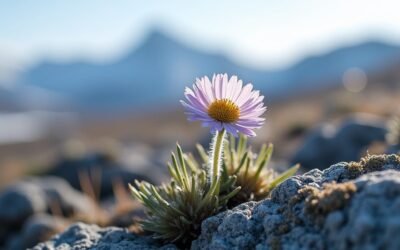In the tundra, key plant species like Arctic Willow, Mountain Cranberry, and Cottongrass are essential. These plants endure extreme cold, nutrient-poor soils, and short growing seasons due to adaptations such as antifreeze proteins and moisture conservation techniques. They play vital roles in soil stabilization, nutrient cycling, and supporting wildlife, forming the backbone of the tundra ecosystem. Mosses and lichens also contribute by conserving moisture and providing critical cover and food sources during the brief summer. Understanding these interactions and adaptations offers a fascinating glimpse into the resilience of tundra flora. Further exploration reveals even more about their integral roles.
Main Points
- Arctic Willow and Mountain Cranberry are crucial for wildlife sustenance and soil stabilization.
- Mosses and Lichens are vital for moisture conservation and nutrient cycling.
- Cottongrass supports various wildlife species and helps prevent soil erosion.
- These plants have adaptations like antifreeze proteins to survive extreme cold.
- Rapid summer blooming of tundra plants is essential for the ecosystem's energy flow.
Tundra Biome Overview
The tundra biome, characterized by its vast, treeless plains and underlying permafrost, offers a stark yet striking landscape. In this extreme environment, plants must adapt to survive the cold, harsh conditions. The soil in the tundra is thin and nutrient-deficient, challenging the growth of many species. Yet, despite these limitations, a variety of plants have evolved to thrive here.
You'll find that the low temperatures and icy conditions of the Arctic tundra greatly influence how plants grow. These species have adapted in remarkable ways to cope with the cold and exploit the short growing seasons. For instance, most tundra plants are low to the ground, which helps reduce exposure to icy winds and preserves heat. This adaptation is essential for survival in an ecosystem where warmth is a rare commodity.
Moreover, the permafrost affects water availability since only the top layer of soil thaws in summer, limiting root growth. Tundra plants, thus, have adapted to grow, reproduce, and complete their life cycles quickly within this brief thawed period. Their resilience is a proof of the power of adaptation in some of the planet's most challenging conditions.
Dominant Tundra Plants
In tundra ecosystems, dominant plants like Arctic Willow and Mountain Cranberry have uniquely adapted to the harsh conditions. These species, along with Cottongrass, Mosses, and Lichens, form the backbone of the tundra biome's flora. While you might think of these areas as barren, the tundra is teeming with life, thanks in part to these resilient plants.
Arctic Willow, a low shrub, thrives where few trees can, enduring the biting cold and strong winds. Similarly, Mountain Cranberry flourishes, producing berries even in the chilly climate. Cottongrass, another dominant species, dots the landscape, swaying with the Arctic breeze. Together, these plants aren't just survivors; they're the pillars that support the entire ecosystem.
Mosses and Lichens also play an important role, carpeting the ground and conserving moisture, which is scarce in these nutrient-poor soils. When the brief summer arrives, tundra plants bloom rapidly, capitalizing on the short period of warmth and sunlight to reproduce. This burst of life is vital, as it ensures their continuation in the demanding tundra biome. Each species' adaptations are a proof of nature's ingenuity, allowing a rich tapestry of life to flourish in this extreme environment.
Plant Survival Strategies
Understanding how tundra plants such as Arctic Willow and Mountain Cranberry manage to thrive can offer insights into their sophisticated survival strategies. These species, along with others like Arctic Blueberry, have developed perennial lifecycles, allowing them to endure through the extreme cold and brief growing seasons typical of the tundra ecosystem. Their ability to produce antifreeze proteins is essential, as it prevents cellular damage during freezing and thawing cycles.
Moreover, these plants display remarkable adaptations for moisture conservation. They've evolved low growth forms and reduced leaf sizes to minimize water loss, which is important in nutrient-deficient soils. You'll also find that UV protection is a key trait, helping shield them from intense ultraviolet radiation that could otherwise be harmful.
Wind resistance is another critical adaptation; their sturdy structures and low statures reduce damage from strong Arctic winds. Additionally, nitrogen fixation enables them to thrive in poor soils by converting atmospheric nitrogen into usable forms. This not only supports their growth but also aids in their unique reproductive strategies, ensuring their survival and continuation in such a harsh environment. These features collectively illustrate the resilience necessary to thrive in the challenging conditions of the tundra.
Flora's Role in Ecosystem
Tundra plants are essential for supporting wildlife by providing food and shelter, stabilizing soil, and enhancing nutrient cycling. As you explore the tundra ecosystem, you'll notice how these resilient plant species play a pivotal role. Despite the extreme conditions, tundra plants not only survive but thrive, forming the backbone of this unique biome.
Here's how they contribute to the ecosystem:
- Soil Stabilization: By binding the soil, tundra plants prevent erosion, which is critical in such a fragile environment. Their roots help hold the ground together, maintaining the structure of the landscape.
- Nutrient Cycling: These plants engage in symbiotic relationships with fungi, which enhance their ability to absorb nutrients. This process is essential for nutrient cycling, replenishing the soil and supporting the growth of various plant species.
- Biodiversity and Resilience: Tundra plants adapt to harsh conditions, showcasing an incredible level of biodiversity and resilience. This adaptation supports a variety of wildlife species, each relying on the unique characteristics of these plants for survival.
Understanding the role of flora in the tundra helps you appreciate the intricate connections and the critical balance maintained despite the challenges posed by the environment.
Human Impact on Tundra
While the resilience of tundra plants forms the backbone of their ecosystem, it's essential to assess how human activities are impacting their survival. You may not realize it, but activities like mining and oil drilling are significant disruptors in these regions. These operations not only disturb the physical environment but also lead to the destruction of vital plant habitats, altering the balance of entire ecosystems.
Pollution is another byproduct of such industrial activities. The contaminants from these processes seep into the soil and water, which can severely affect the health of tundra plants. This pollution, coupled with climate change driven by human actions, modifies temperatures and precipitation patterns, further stressing these hardy species.
You've also got to take into account the effects of overgrazing. Introduced domestic animals can decimate the native vegetation, leaving the tundra barren and vulnerable. It's not all doom and gloom, though. Conservation efforts are in place aiming to mitigate these impacts through sustainable practices. By supporting and enhancing these efforts, you play a part in preserving these unique ecosystems for future generations. Remember, every step towards reducing our footprint counts in keeping the tundra thriving.
Future of Tundra Flora
As climate change continues to reshape the landscape, the future of tundra flora hangs in the balance. You're witnessing a significant transformation in these fragile ecosystems, where plant distribution and biodiversity are shifting due to warming temperatures. Here's what you need to know about the future of tundra flora:
- Shrub Growth: Increased shrub growth in tundra regions is a clear sign of changing environmental conditions. This might seem minor, but it has profound effects on native species and their ability to thrive.
- Adaptation Challenges: Tundra plants are struggling with rapid climate changes. Their ability to adapt is critical, yet they face significant hurdles as the pace of change outstrips their natural adaptation processes.
- Conservation Efforts: It's important to intensify conservation efforts to safeguard these unique ecosystems. Protecting tundra flora not only preserves biodiversity but also helps maintain global ecological balance.
The shifts in plant composition and the increase in shrub growth indicate that tundra ecosystems are under significant stress. You play a part in this story. Supporting conservation initiatives and understanding the impacts of climate change on tundra flora are steps towards a sustainable future for these critical regions.
Frequently Asked Questions
What Are 4 Major Plants in the Tundra Biome?
You're curious about major plants thriving in the tundra biome, where extreme conditions reign. Four prominent species are Arctic Willow, Dwarf Willow, Arctic Poppy, and Cottongrass.
These plants have adapted to harsh climates with unique strategies such as efficient seed dispersal mechanisms and specialized root systems to navigate permafrost. They face challenges like limited soil nutrients and intense photosynthesis demands, yet they play vital roles in their ecosystem, including supporting diverse pollination strategies.
What Plants Tend to Be in the Tundra?
In the tundra, you'll find plants uniquely adapted to extreme conditions. They thrive despite permafrost, nutrient-poor soils, and short growing seasons. You won't see many trees, but mosses and lichens cover vast areas, playing essential ecological roles.
These plants have evolved strategies for wind resistance, efficient nutrient acquisition, and maximizing sunlight exposure. Their reproduction methods guarantee survival in minimal conditions, showcasing remarkable adaptations to one of Earth's most challenging environments.
Which Type of Plant Is Most Likely Found in the Tundra Biome?
Ironically, you won't find towering trees in the tundra biome, but rather small, hardy plants like mosses, lichens, and low shrubs. These species are champions in adapting to permafrost and minimal soil nutrients, thriving despite the challenges of a short growing season and low biodiversity.
They've evolved impressive adaptations, from deep root systems to unique pollination strategies, ensuring their survival amid climate change and maintaining vital nutrient cycling dynamics in this stark landscape.
Which Plant Species Is Best Adapted to Survive in the Tundra?
In the tundra, the Arctic Willow stands out for its adaptation skills. Its shallow roots combat permafrost and poor soil nutrients, while its natural pesticides and robust seasonal growth cycles enhance survival.
The plant's efficient photosynthesis counters low sunlight and harsh temperatures. Moreover, its ability to spread seeds despite strong winds and its strategies for moisture retention guarantee it thrives amid temperature fluctuations, making it exceptionally suited for the tundra environment.
Conclusion
As you've discovered, tundra plants aren't just survivors; they're essential stabilizers in their ecosystem.
Despite their resilience, human activities and climate change pose significant threats.
It's a delicate balance: the robust, enduring flora against the burgeoning impact of human footprint.
Protecting these essential species is necessary for maintaining the tundra's health and, by extension, our planet's climate systems.
The future of tundra flora depends largely on our actions today—let's make informed choices.


